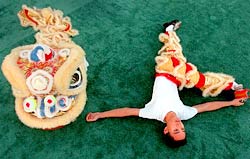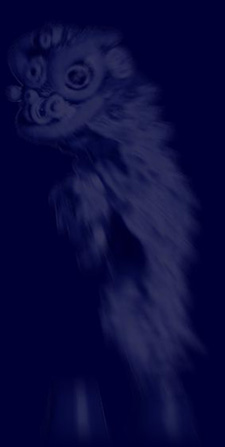- Party
Animals: Lion
dancers bring traditional pride to festive events
-
05/30/2000
-
By
Katie Menzer / The Dallas Morning News
-
For many people, the arrival of a lion at a wedding,
party or grand opening would not be a blessing.
But for Bee Dao, such a visitation is the cat's
meow.
-
"The
lion represents the scaring away of bad luck
and the bringing of good luck," said the
24-year-old graduate student. "It's a blessing."
-
-

Allison
V. Smith / DMN
Albert Nguyen warms up before donning
his costume to practice at J.K. Wong
Kungfu Tai Chi Academy in Richardson.
He joined the academy when he was
10 years old, after seeing a lion
dance at a Chinese New Year's party.
|
-
Mr.
Dao is one of about 30 students of a local kung
fu academy who are practicing lion dancing,
an ancient Chinese ritual that combines exercise
and artistry.
-
-
The
origins of the dance, once performed only by
kung fu scholars, are unclear. But the ritual
is mentioned in Chinese literature dating back
to the Tang dynasty in the seventh through 10th
centuries, said Meng-fen Su, an East Asian studies
librarian at the University of Texas at Austin.
The dance is performed at celebrations by an
increasing number of students and members of
cultural community centers.
-
-
"It's
really competitive and well-respected overseas,
but it's gaining popularity here," said
Mr. Dao, who is a student and teacher of lion
dancing at J.K. Wong Kungfu Tai Chi Academy
in Richardson.
-
-
The
academy's students have performed at a wide
array of places in the Dallas area, from parties
thrown by Dr Pepper/7-Up Inc. to cultural events
at a Mesquite school.
-
-
Mr.
Dao, an MBA student at the University of Texas
at Dallas, said students traveled to Hong Kong
in 1995 to participate in an international lion-dancing
competition.
-
-
Traditional
performances, which can last up to 30 minutes,
are a complex mixture of mime and mythology.
The lion must go through symbolic obstacles,
such as climbing a tree or crossing a river,
before it can receive a prize - often a red
envelope full of money that is the performers'
reward for the dance.
-
-
The
lion dance requires two performers - a head
and a tail - who move in semi-choreographed
tandem to the beat of drums, gongs and cymbals.
-
-
The
lion's head is a framework of bamboo rods covered
with brightly painted papier-mache. The operator
uses a system of levers to make the cat's eyes
flutter or mouth gape. Light bulbs can be used
to make the eyes spark with fiery emotion.
-
-
The
performer in the back is covered with a long
multicolored cloth accented with wool or rabbit
fur that hangs from the lion's head. A fur-covered
stick inserted through the cloth wags the tail.
-
-
Although
the head is the high-profile position, the performer
at the tail is the backbone of the dance, said
Jimmy K. Wong, the sifu - or teacher
- at the academy.
-
|

Allison
V. Smith / DMN
Albert Nguyen (top) and Bee Dao practice
leaps.
|
"The
tail has the toughest job," said Mr. Wong,
a U.S. representative and judge for the International
Dragon and Lion Dance Federation in Hong Kong. "He
has to have very strong hands and back."
The
tail dancer must crouch for most of the performance,
his hands resting on the hips of the dancer in front.
Only when the lion is rearing on its hind legs does
he stand erect, to balance the weight of the front
performer above his head.
Mr.
Wong, who grew up in Malaysia and has practiced
martial arts for three decades, said his students
must study kung fu for at least six months before
they are allowed to don the lion's skin. He said
the strength and discipline gained through the martial
art are essential for good lion dancing.
Albert
Nguyen, who is the head to Mr. Dao's tail, said
he joined the academy when he was 10 years old after
seeing a lion dance during a Chinese New Year's
celebration. Back then, the school had not acquired
any "baby" lion costumes, so he had to
wait almost five years before he was strong enough
to dance with the lion's 8-pound head.
Now
21 and a junior at Texas A&M University, Mr.
Nguyen returns to Richardson about once a month
to practice the dance. He said his favorite parts
of the performances are the acrobatics.
"The
jumping we do is a lot of fun," he said.
"We don't make it a lot of the time in practice,
but we always seem to get it when we're performing.
It's a rush of excitement when the crowd reacts
with enthusiasm. They appreciate it so much because
it's not seen very often."
During
a recent performance at a martial-arts tournament
in Plano, Mr. Nguyen and Mr. Dao jumped a length
of what seemed like the length of a body with
exact synchronicity between small inverted pots
representing rocks in an imaginary river. Although
most dancers at the school practice their routines
for about an hour each week, the performances
often require emergency improvisation.
"Most
of the time it is choreographed, but sometimes
something will happen with your equipment and
the lion will have to improvise," Mr. Dao
said. "What are you supposed to do if something
topples over? You can't stop the show. You react
calmly inside, but express excitement on the outside
like any animal would when something sudden and
unexpected happens. Lion Dance requires quick
instinct and trust in your partner."
Although
the lion costume is often mistaken for a dragon,
lion and dragon dances are distinct Chinese rituals,
Mr. Wong said. The dragon dance, which can involve
a dozen performers, is used as a celebration.
The dance of the lion, thought to be the guardian
of the heavens, is used to bring luck. The lion
serves as a connection between heavens and the
earth.
Mr.
Wong likens the lion dance to a game of basketball
- each team member must excel to win. "It's
the best representation of China," Mr. Wong
said. "When you see the lion dancing, it's
unique."
|

